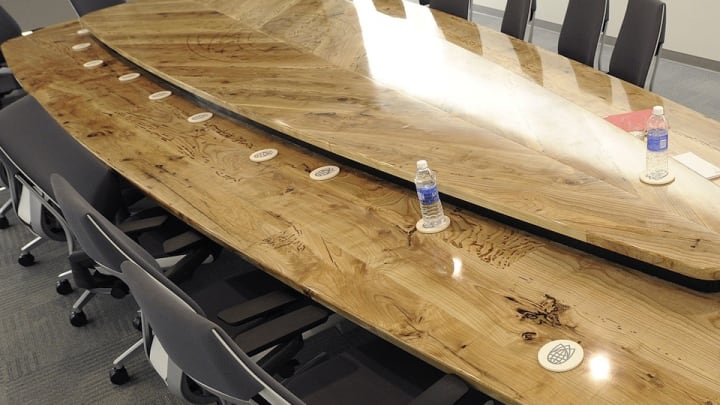Pac-12 gives students a voice at the table. Will others follow suit?

When University of Utah faculty athletic representative Karen Paisley first participated in a council meeting for the Pac-12—one of the country’s most powerful collegiate sports conferences—she remembers being struck by one question in particular:
Where are all the student-athletes?
“We’re talking about student-athlete issues, and it was just fascinating to me that they hadn’t been included,” recalls Paisley, who will serve as the Pac-12's Council President this year.
This time around, as she and other delegates met for the Pac-12 Council’s annual fall meetings in San Francisco on Oct. 21 and 22, Paisley didn’t sense a missing piece to the puzzle. With the presence of the Student-Athlete Leadership Team (SALT), the Pac-12 became the first major NCAA conference to include student-athlete views in its voting-governance structure, giving them an active voice in the body’s legislative discussions — particularly those involving issues of student welfare.
“Philosophically, it’s consistent to have them at the table,” Paisley said. “It felt right; it felt complete.”
The inclusion of SALT is the result of an Oct. 2014 decision by the Pac-12 CEO group —consisting of the conference’s presidents and chancellors — to include the student group in the formal governance process. SALT is now the fourth subgroup on the Pac-12 Council, joining the Athletics Directors, Faculty Athletics Representatives and Senior Woman Administrators. The committee is comprised of two student-athletes from each of the conference’s member schools, and will be incorporated into the body’s one-school, one-vote governing protocol.
Twelve members were in attendance for the conference’s meetings in October, and the general consensus, according to Pac-12 Commissioner Larry Scott, was that the discussions were far more effective with the presence of a a genuine student-athlete voice.
“Probably a lot of people left thinking, ‘Wow, we should’ve done this sooner,’” Scott said.
The council discussed a number of ideas the conference is hoping to incorporate at the upcoming Autonomy Session of the 2016 NCAA Convention. The main talking points included schedule demands, the use of student-athlete images and likenesses, and financial assistance.
Now that student athletes finally have a voice at the table, Paisley said she and other administrators are quickly realizing how much work remains to be done.
“Sometimes, what we think is in their best interest doesn’t play out that way,” she said. “We've committed to multi-year grant contracts, and once the student is put on aid, the aid can’t move.”
Still, Paisley has learned that student-athletes are largely skeptical of the grant-contract approach, citing that coaches often use the ability to raise or lower financial aid as a means of motivating individuals.
“If they can’t remove aid, they believe it might encourage kids to slack off because the pressure wasn’t there,” Paisely said. “That for me was one of the big highlights, because it would’ve never occurred to me that that wasn’t a good idea.”
For his part, Commissioner Scott said he was surprised by how strongly student-athletes felt about the prospects for using their names, images and likenesses to promote other, non-athletic business ventures.
“They added so much texture and nuance, and I think caused us to rethink some elements of our proposal that we would not have sought to rethink,” Scott said. “As a result, we will have a much better, more thoughtful, more effective proposal to put forward.”
Until a few weeks ago, Pac-12 student-athletes had only been informally involved in the conference’s policy-making apparatus, with each member school having its own Student-Athlete Advisory Committee (SAAC) to discuss the issues inherent to student-athlete welfare. But because each SAAC was tied to the school’s athletic department, a cross-pollination of ideas across schools was inherently difficult.
“I think student athletes had varying degrees of voices at their different schools,” said Clare Wise, Chair of the Pac-12 SALT and a member of Colorado’s alpine team. “But, this gives us our first chance to come together as a conference, and kind of stand united.”
In a way, SALT’s involvement in the Pac-12 council meetings is similar to what occurred at the NCAA Convention in January, when student-athletes from the nation’s “Power Five” conferences — the Big Ten, Big 12, ACC, SEC and Pac-12 — voted on proposed NCAA rule changes for the first time.
But the Pac-12 may be the clearest bellwether yet for where other conferences (and NCAA-athlete relations in general) may be headed, with increasing emphases placed not just on student-athlete support, but also on a genuine student-athlete voice.
As Scott mentioned, the Power Five have made significant strides over the past two years: Scholarships can now cover the full cost of attendance, multi-year grants are on the table, and increased medical coverage for injuries sustained during college have become much more the rule than the exception.
Plenty of work remains to be done, of course—a fact thrown in high, uneasy relief by recent student protests at the University of Missouri, where numerous student groups (including the football team) came together to oust the school's president, offering a more radical template for what future student-athlete movements might look like.
Still, despite the Pac-12's more collaborative approach, including student-athletes in the governing process has helped the conference set a standard by which its peers will increasingly be measured: Allowing the students themselves to have a direct input on important, potentially landscape-altering decisions.
“Most of the things we talk about are about what would be good for student athletes,” Scott said. “It’s obvious to me that hearing student athletes directly adds a lot of valuable insight and information to these deliberations.”
